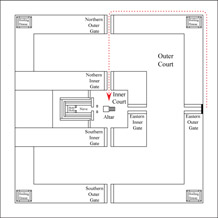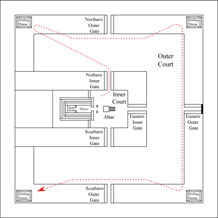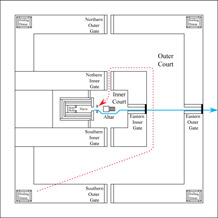
CONT., page 8
EZEKIEL’S TEMPLE
There
is considerable confusion, wonder, and opinion as to what Ezekiel’s temple
might be or represent. Some hold it
to be literal, while others regard it to be figurative or spiritual. The dimensions provided in Ezekiel 40
through 47 certainly do not correspond to any of the previous temples; and the
temple is in fact distinctly different in many ways, including religious practices
and procedures. There is no laver,
no table of showbread, no lampstand, no altar of incense, no veil, and no ark
of the covenant. The only items
that are there are the altar for burnt offerings that
is in the inner court, and a single and unique wooden altar in the holy
place. And in contrast to previous
temple altars located in the inner court that were supposedly approached from
the south by a ramp, this altar is approached from the east (Ezekiel 43:17),
and there are steps that in prior temples were forbidden (Exodus 20:26). In addition, quite uniquely a river
flows eastward from the threshold of the temple, where no river has ever flowed
before. Also, its ever-increasing
flow is entirely unnatural and unrealistic, along with the trees that continually
bear fruit and their leaves are for healing, as well as the fact that the water
goes to the sea and those waters are healed.
We
will look at some of the specifics of the chapters that deal with the eastern
gate. But before we do, as
indicated by what you just read, you will see that Ezekiel’s temple is indeed a
representative type of that which was to be. It will never be built as a natural
stone temple, as many Christians and Jews alike suppose. And in fact, as you will see, for the
last 2,000 years it has been in the process of fulfillment. But just like the natural tabernacle and
temples, it too has been a shortfall!
In addition, it too will have to be torn down and replaced. Despite the hopes and promises of those
structures in past times, they all failed and were torn down. And this spiritual temple will follow
the same inevitable fate.
Why
would it be otherwise with this one?
It too is of this earth, and we repeatedly read that the things of this
world are passing away. It is the
spiritual that we must have—that which is from Jerusalem above. And as you will see, the weakness and
failure of this temple comes because it still relies upon natural man—the spiritual being given to natural man. This has been the problem since the
Garden, including the last 2,000 years of the church. As has been proven time and time again,
this mix of heavenly and earthly is guaranteed failure! You will be amazed at all you are about
to read and learn here. Let us now
look at the specifics of these highly relevant and revealing chapters regarding
the eastern gate.
In
Ezekiel 43:1, Ezekiel was led to the eastern gate located on the outer
wall. The fact that it is the outer
gate is proven in the preceding chapter, verses 15-20. Ezekiel 43: 2-4 continue:
. .
. and behold, the glory of the God of Israel was coming from the way of the
east. And His voice was like the
sound of many waters; and the earth shone with His glory. And it was like the
appearance of the vision which I saw, like the vision
which I saw when He came to destroy the city. And the visions were
like the vision which I saw by the river Chebar; and I fell on my face. And the glory of Yahweh came into the
house by the way of the gate facing toward the east.
Before
proceeding any further, let me tell you what is about
to unfold, for we will be taken on a journey that successively leads in and out
of the temple. What you just read
in chapter 43 takes us to the outer east gate. But what you will find is that there is
also an east gate on the inner wall that encompasses the inner court. In the following diagram, you can see
the general layout of Ezekiel’s temple.
You will notice that there are three pairs of gates: an inner and outer north gate, an inner
and outer east gate, and an inner and outer south gate. There are no west gates. You will also notice that there is an
outer court and an inner court, where the altar was located. In this diagram, our beginning location
at the outer east gate is marked with a red arrow. Also, there is a gold line, showing that
“the Glory of the God of Israel” passed through the east gate.
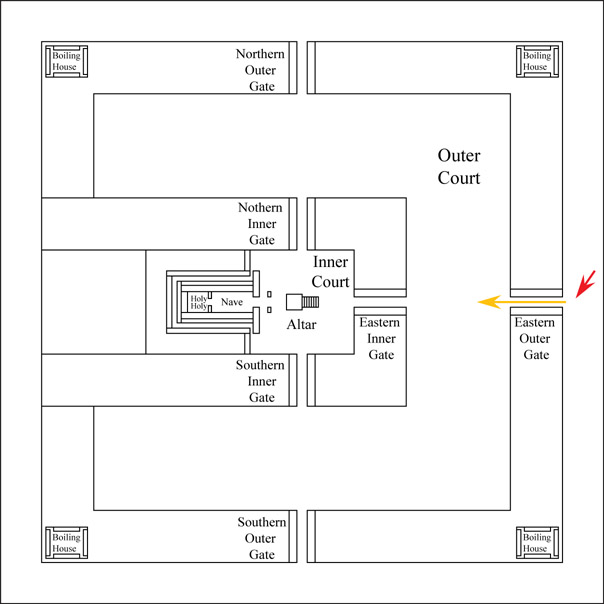
After
going to that outer gate facing east as we just read, next we will be taken
into that inner court. Then in
chapter 44, verses 1-2, we are taken back to the outer gate facing east. Then in verse 4 we are taken through the
north gate back to the inner court.
Next, in chapter 46 we briefly go to the outer court; and in chapter 47,
verse 1, we go back into the inner court.
Finally, we go back through the north gate and around to the outer east
gate. So to summarize the places
and chapters in this journey we see:
1. Outer
east gate (43:1-4)
2. Inner
court (43:5f)
3. Outer
east gate (44:1-2)
4. Inner
court (44:4f)
5. Outer
court (46:21f)
6. Inner
court (47:1)
7. Outer
east gate (47:2f)
So
remember, we go out, . . . in, . . . out, . . . in, . . . out, . . . in, . . .
out! I hope this helps in what are already a most difficult five, and even nine chapters to
understand. Also to help, as you
see at the beginning of the next paragraph, anytime we are about to change
locations, this is marked by a parenthetical notation that is based on the above enumerated key.
Furthermore, we will repeat the diagram in a smaller version, marking
the locations and the journeys. Let
us continue.
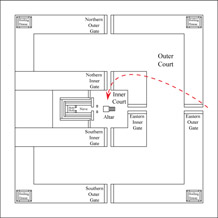 (2.–In) After going to the outer gate facing
east in chapter 43, Ezekiel was then lifted up by the Spirit and brought into
the inner court, which is were the altar is located, and “the glory of Yahweh
filled the house” (vs. 5). Verses
6-7 continue:
(2.–In) After going to the outer gate facing
east in chapter 43, Ezekiel was then lifted up by the Spirit and brought into
the inner court, which is were the altar is located, and “the glory of Yahweh
filled the house” (vs. 5). Verses
6-7 continue:
Then I heard one speaking to me from
the house, while a man was standing beside me. He said to me, “Son of man, this
is the place of My throne and the place of
the soles of My feet, where I will dwell among the sons of Israel forever.”
Then
in verse 12, Yahweh speaking from the house added:
This is the law of the house: its entire area on the top of the
mountain all around shall be most holy. Behold, this is the law of the house.
After
saying this, the measurements of the altar were set forth, as well as its
purification procedure. (3.–Out) We
will comment about this altar shortly, but let us now go to chapter 44. Here we read in verses 1-2:
Then He brought me back by the way of
the outer gate of the sanctuary, which faces the east; and it was shut. Yahweh said to me, “This gate shall be
shut; it shall not be opened, and no one
shall enter by it, for Yahweh God of Israel has entered by it; therefore it
shall be shut.”
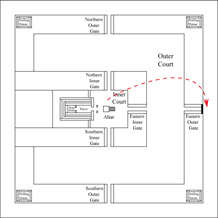 First, this “outer
gate . . . which faces the east, and it was shut” spoken of here, is the same
gate addressed in 43:2-4. (You will
notice in the diagram the gate is now shut.) Note the similarities of these
descriptions. There we read, “the glory of the God
of Israel was coming from the way of the east. . . . And the glory of Yahweh came into the house by the way of the gate facing toward the
east.” Chapter 44, verses 1-2,
then affirm that which had taken place in the previous chapter—“for Yahweh God of Israel has entered by it;
therefore it shall be shut.” This
closure is further confirmed in Ezekiel 47:2, which will be addressed shortly,
where we read, “He brought me out by way of the north gate and led me around on
the outside to the outer gate by way of the gate that faces
east.” Here again, the way to get
to the outside of the closed east gate was to now go out the north gate and
around to it. Again, the outer east
gate is the one that has been closed because Yahweh God of Israel entered
through it.
First, this “outer
gate . . . which faces the east, and it was shut” spoken of here, is the same
gate addressed in 43:2-4. (You will
notice in the diagram the gate is now shut.) Note the similarities of these
descriptions. There we read, “the glory of the God
of Israel was coming from the way of the east. . . . And the glory of Yahweh came into the house by the way of the gate facing toward the
east.” Chapter 44, verses 1-2,
then affirm that which had taken place in the previous chapter—“for Yahweh God of Israel has entered by it;
therefore it shall be shut.” This
closure is further confirmed in Ezekiel 47:2, which will be addressed shortly,
where we read, “He brought me out by way of the north gate and led me around on
the outside to the outer gate by way of the gate that faces
east.” Here again, the way to get
to the outside of the closed east gate was to now go out the north gate and
around to it. Again, the outer east
gate is the one that has been closed because Yahweh God of Israel entered
through it.
Now,
a side comment is necessary here.
Christians and Jews alike make a big to-do that the eastern gate in
present Jerusalem is likewise closed.
And, they quote these verses in Ezekiel 43 and 44 as though they are a
prophecy about and relevant to that gate, when in fact that gate has nothing whatsoever
to do with Ezekiel’s temple. Then they
wrongly postulate that Yahshua will return and pass through that gate once
again. Well, that might make great
drama akin to “Raiders of the Lost Ark,” but the reality is that both are
fiction. How can anyone take a
prophecy regarding Ezekiel’s temple, and apply it to a gate possibly rebuilt by
the Romans around 520 AD, and the Muslim Ottomans sealed off in 1541? That gate has absolutely no relationship
whatsoever to the east gate of Ezekiel’s temple! If it did, where is the rest of the
temple? (More on this
shortly.) Man once again proves
that his thinking is natural, and not heavenly.
In
this regard, Paul clearly stated that natural Jerusalem is Hagar, and is in
slavery—the bondwoman according to the flesh (Galatians 4:22-25). But Jerusalem above, who has been barren
up to now (no one has yet to enter into immortality
except Yahshua) is the fulfillment we MUST have. So why should anyone look to natural Jerusalem/Hagar with any hope whatsoever
regarding the kingdom of heaven or the coming of Immanuel? They would all be sorely disappointed
and die waiting for the fulfillment of their false expectations. Again, they are natural men performing
natural thinking—attempting to work the kingdom out in the flesh.
So,
we read that the inner gate facing east, the gate leading into the court of the
sanctuary where the altar is located and provides passage into the sanctuary,
is closed for six days, but is opened on the seventh day, the sabbath. I hope you understand this, for it will
be quite important when we see what Yahweh is telling us regarding all of
this.
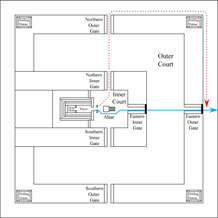 (7.–Out) Finally, continuing with verse 2 of
Ezekiel 47, we read the concluding leg of this journey where we go back to
where we began, back to outside of the outer east gate:
(7.–Out) Finally, continuing with verse 2 of
Ezekiel 47, we read the concluding leg of this journey where we go back to
where we began, back to outside of the outer east gate:
He brought me out by way of the north
gate and led me around on the outside to the outer gate by way of the
gate that faces east.
And behold, water was trickling from the south side.
So,
the water originating from the inner court now makes its exit under this
outside eastern gate. What we are
getting ready to read is very much so key to understanding what this temple’s
fulfillment truly is, and what is expected in that fulfillment. Here now are verses 3-5 in a more
literal translation, laid out measurement by measurement:
When the man went out toward the east
with a line in his hand, he measured a thousand cubits, and he led me through
the water, the waters of the soles.
Again he measured a thousand and led me
through the waters, the waters of the knees.
Again he measured a thousand and led me
through, the waters of the
loins.
Again he measured a thousand; and
it was a river that I could not ford, for the water had risen, waters
of swimming, a river that could not be
forded.
When
I began examining these chapters in Ezekiel, I had no idea what this temple was
prophesying or representing. It was
far too complicated to understand.
And it was not until I considered these three verses that its
representation became evident.
In
past writings, I have often considered this water to be the latter rain, and
this can indeed still be relevant.
But there was one item here that could never be computed into that
consideration—the four successive measurements of a thousand cubits
each. Finally, on this occasion I
had to consider what these 4,000 cubits meant. First, I wondered if maybe they were
relative to upward higher dimensions, but immediately dismissed that
prospect. Then I asked the frank
question that if they were in fact representations of four 1,000-year periods
of time, where would they lead?
Hereupon,
relative to the church that began 2,000 years ago, we see that 1,000 years of
waters of the soles, and 1,000 years of waters of the knees, would take us to
where we are today. Well, that
indeed made sense. Essentially all
translations of verse 3 say that it was water “to the ankles.” But the Hebrew word they translate as
“ankles” literally means “end.” And the end is not the ankles, but
instead the souls of the feet. And
we know that the souls or feet represent kingdom rights. This is evidenced in that Abraham was
given everything the souls of his feet had touched, and Yahshua washed the
disciple’s feet. And in Ezekiel
43:7, which we recently read, Yahweh declared, “Son of man, this
is the place of My throne and the place of
the soles of My feet, where I will
dwell among the sons of Israel forever.”
Christianity did indeed receive the rights to the kingdom of heaven on
earth.
To
understand the waters of the knees, in 1 Kings 18:42
we see that Elijah prayed on Mount Carmel by crouching down and placing “his
face between his knees.”
Prophetically and intercessorally, it is the
same as Yahweh saying that He would place Moses in the cleft of the rock and he
could not see (Exodus 33:22). It is
the same as Jeremiah being instructed to place a linen waistband in the cleft
of the rock, it thereby becoming worthless (Jeremiah 13:4-7). It is the same as wrapping the dead body
of Christ in linen and placing it in the cleft of a rock (Luke 23:53). Clearly, the face between the knees is
the breach period of the Body of Christ, evidenced here with the waters of the
knees. So, the first 2,000 cubits
of the waters of the souls/feet and the waters of the knees, are exactly the
timing and experience of where we are today—the church receiving the
kingdom rights, while hidden in the cleft of the rock.
Next,
we see that the third-part 1,000 years of waters of the loins would take us
through the Millennial Reign. This
would be the seventh day, even the day when the inner east gate could be
opened. First, let us note that this third part was also testified to by Elijah. In verses 43-46 of 1 Kings 18, during
the time his face was hidden in the cleft between his knees, seven times he sent his servant to look
toward the sea. Here again, just
like the seven sprinklings of the blood or the seven-branched lampstand, this
is Christianity. After these seven
times, the servant came back with the report of seeing a cloud the size of a
man’s palm. Thereupon, Elijah
girded his loins and outran Ahab to Jezreel.
We
have noted that Christianity was supposed to get 3,000 years in order to fulfill
the kingdom of heaven. If they were
successful, they would continue to make progress in this third part, gird up
their loins in the waters of the loins, and succeed. And as noted in previous writings, with
this success they would have completed their labors and rested on the sabbath they have evidenced for 2,000 years—the eighth
day, or Sunday. The reason
Christians call Sunday the sabbath is because,
governmentally, if they could be successful with their 3,000 years, they would
rest on the eighth day. And as we
see here, the seventh day would have been their waters of the loins, and their
eighth day would have been their waters of swimming! What are waters of swimming? These are the waters where one is not
connected to this earth anymore. It
is ascending alive, just as Yahshua did so on his fourth year as well. His ministry was for three and a half
years, and in His fourth year He did that which the Body of Christ would never
do in their fourth 1,000-year period.
Remember, as went Christ, so goes the Body of Christ. But, because they are earthly flesh men,
they fail (e.g., lacking the power of resurrection); and Yahshua has to come
and perform what they fail to accomplish.
It
is most interesting that there is a Christian web page—which quite appropriately
is chapter 7 from a book—that lays out the very thing we have been seeing
here pertaining to Christianity’s foreshadowed success in their fourth-part
sabbath. Here, the author does a
great job in describing the layout of the temple. But, what he presents is still natural
thinking, as he proposes that Ezekiel’s temple is the natural temple that will
be built in the Millennial Reign.
Here is the link to the web page:
“The
Millennial Temple.”
In
his work he lays out what he calls the “temple history,” and identifies what He
calls the dwelling places of God.
Appropriately, there are seven of these—the seventh being
Christianity’s eighth-day sabbath rest. The first place is rightfully the Garden
of Eden. He then moves forward to
the second place, which is 500 years of the tabernacle (1500 BC to 1000
BC). The third place is 500 years
of Solomon’s temple (1000 BC to 500 BC).
Fourth is 500 years of the second temple (500 BC to 0). This now of course comes to the 2,000
years the church, the Body of Christ, which is the fifth (0 to 2000 AD). The sixth dwelling place is the Millennial
Reign, or what he thinks will be Ezekiel’s natural temple (2000 AD to 3000 AD).
And most interestingly, the
seventh, the sabbath, which is in fact the eighth day
of man, he calls the “Bride of Messiah.”
What he is saying is that the Body of Christ fulfills the Bride on what
is actually the eighth day!
That
which he lays out here is truly the test of Carmel as to who will be the Bride
and enter into immortality! And if
Ezekiel’s temple was fulfilled, not in the natural way
as this man expects but in the spiritual, he would be right. But the very fact that he is still
looking to the natural, his hopes will fail, just as Christianity as a whole
has failed.
Let
us briefly examine two more testimonies of this failure and its
consequences. We already see the
great significance of Tabernacles for today. Also, we have noted that Yahweh
propounds contradiction riddles.
Regarding these riddles, in The Key To Their Understanding,
Page 5, we find that the books of Samuel and
Kings reveal or represent Christianity, while the books of Chronicles reveal or
represent the two Remnant. Keeping
this in mind, we find that when Solomon’s temple, a type of the Millennial
Reign, was dedicated appropriately during Tabernacles, in Christianity 1 Kings
8:66 the people were sent home “on the eighth day,” which would have been the
twenty-second. But in contrast, in
Remnant 2 Chronicles 7:10 the people were sent home “on the twenty-third day of
the seventh month,” after the eighth day.
Thus we see that in Christianity Kings the people did not participate in
the great eighth day when Yahshua promised that from one’s “innermost being
will flow rivers of living water” (John 7:38). But in contrast, in Remnant Chronicles the
people did participate. Therefore,
evidenced here we find that on Christianity’s great eighth day, their sabbath, they would not enter into Yahweh’s culminating
rest. Rivers of living water (deep
enough in which to swim) would not flow from them and they would have to depart
from the temple on that eventful day.
And in contrast, the Remnant experience that great eighth day, and with
time cut short, even early.
In
like testimony, in Luke 13:6-9 Yahshua told a parable where a man had a fig
tree, which
is prophetic of Christianity, and for three years
it brought forth no fruit. These
would be the fifth, sixth, and seventh days of man—the three-part period
Christianity is supposed to receive.
He therefore instructed the gardener to cut it down. However, instead the tree was to be
fertilized and left alone for the next year—Christianity’s eighth-day sabbath rest.
But if it did not produce fruit the following year, it was to be cut
down. Though these two testimonies
are slightly different in the way this is accounted, the outcome is the
same—rejection and loss!
This
is why today we so desperately need for Yahweh to have mercy, cut time short,
and establish His true Remnant Bride now, take her to heaven, make her one
flesh with Him, and return to rule and reign on this earth in the Millennium,
the seventh day.
Thus
we see that those 4,000 cubits of water flowing from the temple were a
testimony of what the 4,000 years of the Body of Christ would be if they were
successful. This was the key I
needed so as to be able to see what Ezekiel’s temple truly represented. With
the highly unique testimony of this river—beginning in the temple inner
court and flowing under the two closed east gates, increasing with increments
of four units of 1,000 cubits each, flowing to the sea and healing it, and the
trees continually producing fruit and the leaves for healing—it was quite
obvious that this temple was not literal stones, but solely prophetic. And let it be added here, if Christians
were indeed successful with their 3,000 years, as well as their eighth-day
sabbath rest, then the outcome would indeed be that the dead (the sea) would be
healed, their fruit would be endless, and their leaves would bring healing. BUT, they have failed for 2,000 years,
and would continue to fail if given more time! Therefore, Yahweh has to cut their time
short from 3,000 years to 2,000 years, and perform on the seventh day, the
loins day, what they would totally fail to accomplish—bringing forth the
required fruits of the kingdom.
Do
you see then that Ezekiel’s temple
evidences what the Body of Christ, Christianity, would be IF they were
successful? This
river, as well as other clear testimonies, most certainly attest to
this. It is written, “knowledge is
easy to one who has understanding” (Proverb 14:6). Having this understanding of what
Ezekiel’s temple truly is, we can see the meaning of other like testimonies
found in this temple, some of which we will now address.
Let
us begin with the very important testimony of the outer gate facing east being
closed. In Ezekiel 44:1-2 we read:
Then He brought me back by the way of
the outer gate of the sanctuary, which faces the east; and it was shut. Yahweh said to me, “This gate shall be shut; it shall not be opened, and no one shall enter by it, for Yahweh God of
Israel has entered by it; therefore it shall be shut.”
Here
again, we see a case of ignorance and blindness on the part of Christians (and
Jews). What did that passage just
say? Did it say that the gate would
be closed until the Son of God would pass through it? That is what Christians tell us, and
they even make this claim regarding a gate the Roman’s built in a city that is
Hagar. That gate is closed in
Ezekiel for one reason: “Yahweh God of Israel
has entered by it”! He
never passed through that Roman gate.
And whatever gate He did pass through can NEVER be
opened again!
How
can Christians claim Yahshua is coming through that gate AFTER it is already
closed? They claim that He is
coming again to go through it a second time (when it was not even built until
520 AD). But, that passage clearly
states: “This gate shall be shut; it shall not
be opened”! That natural gate in
Jerusalem is an inaccuracy in many ways, like unto acclaimed Catholic relics of
the actual cross upon which Yahshua was crucified.
So,
what is Yahweh really telling us here?
And when and how will Yahshua return? That true eastern gate was closed when
God became flesh and Yahweh/Yahshua walked through it by coming to this earth
as a man and fulfilling His role as Savior. Remember, this entire temple is
spiritual; and as we saw with the ark of the covenant,
the east is death! He came early
and died for man and then left, leaving the kingdom of heaven in the hands of
the Body of Christ; and that closed gate attests to Yahshua’s completed work as
Savior. “It is finished!” It is closed! Thus, Ezekiel’s temple, the work of the
Body of Christ, was in fact initiated when 2,000 years/cubits ago He passed
through that spiritual gate. And,
as Jews and Christians await the reopening of that
Jerusalem eastern gate, they are in fact proposing re-crucifying the Son of
God!
In
further confirmation of this representation of the Body of Christ, on the seventh
day in Ezekiel’s temple, who is it who passes through
the inner eastern gate? Is it
Yahshua and His Bride? No! It is the Body of Christ. In Ezekiel 46:12 we read:
When the prince provides a freewill offering, a burnt offering, or peace
offerings as a freewill offering to Yahweh, the gate facing east shall be opened for him. And he shall provide his burnt offering
and his peace offerings as he does on the sabbath
day. Then he shall go out, and the
gate shall be shut after he goes out.
There
is common agreement that for many reasons this prince who passes through the
gate facing east is not Yahshua; but who he is is
debated. However, knowing what we
now know, the answer to this question is clear and confirming. Of course we know that Yahshua is
identified as the “Prince of Peace” (Isaiah 9:6). Also, in Daniel 9:25 He is identified as
“Messiah the Prince.” Now, if
Christ came and thereupon was formed the Body of Christ; then is it not equally
true that His coming as Prince means that the Body of the Prince also
followed? Very
much so. In fact, in Daniel
9:26, Yahshua’s followers are specifically called “the
people of the Prince.”
Therefore, this explains who this mysterious prince is in Ezekiel. He is an affirmation of this temple
being the Body of Christ. He is the
Body of Christ. Furthermore, we see
in this sabbath entry that if they could be
successful, they would receive the waters of the loins and enter the inner
court through the inner east gate on the seventh day. But they will not. More will be said concerning this
shortly.
One
other like affirmation of the prince being the Body of Christ is seen in
Ezekiel 44:3. In verses 1-2, we see
the second trip to the now-closed outer east gate. While at that gate, verse 3 tells us
regarding the prince:
“As for the prince, he shall sit in it
[the closed east gate that is a type of Yahshua’s coming and death] as prince
to eat bread before Yahweh; he shall enter by way of the porch of the gate and
shall go out by the same way.”
So,
the prince is to eat his bread on the porch of the closed east gate that
testifies to Yahshua’s coming to this earth and laying down His life. Is that not yet another clear evidence
as to the identification of the prince with the Prince—being the Body of
Christ? Very much so! Eating that bread is the same as eating
His flesh—identifying with His death. And fittingly, the porch was on the
inside of the temple (Ezekiel 40:7-9), inside this kingdom work. (Another excellent and very thorough
analysis of Ezekiel’s temple with many images, including this porch, can be
seen here. Though again, this is Christian
commentary that is natural.)
Another
evidence that Ezekiel’s temple is the Body of Christ is that the only piece of
furniture in it is the altar.
Though it is not stated that the altar is bronze, that
is the element from which other altars were made, and bronze is consistently
the element that is identified with Christianity.
Also,
in Ezekiel 43:18-27 we see that the consecration of this altar is a 1 – 6
– 1 pattern process. Day 1 is a bull offering. Days 2-7 are four different animal
offerings each day. And on day 8
and onward they could make burnt and peace offerings, and Yahweh says, “I will
accept you.” This burnt offering on
the eighth day is the same testimony of waters deep enough in which to
swim—both an ascending to God.
Obviously, if Christianity had been successful, this would be their
ascension on the eighth day, their sabbath, the waters
deep enough in which to swim.
And
though this altar itself is not identified as bronze, bronze does appear in yet
another attesting manner. In
Ezekiel 40:3, at the very beginning of this series of chapters on the temple,
we read the description of the man who would measure this Body of Christ
temple:
. .
. and behold, there was a man whose appearance was like the appearance of bronze, with a line of flax and a
measuring rod in his hand; and he was standing in the gateway.
So,
bronze Christianity is attested at the very outset of this entire temple
revelation.
Also,
providing possible foreshadowing testimony that this temple would fail, is the
first statement made relative to the east gate in Ezekiel 43:1-3:
Then he led me to the gate, the gate
facing toward east; and behold, the glory of the God of Israel was coming from
the way of the east. And His voice
was like the sound of many waters; and the earth shone with His glory. And it was like the
appearance of the vision which I saw, like the vision which I saw when He came to
destroy the city.
The
vision Ezekiel was speaking of is that found in Ezekiel 9 regarding the
judgment of Jerusalem. In verse 2 we
read:
Behold, six men came from the direction
of the upper gate which faces north, each with his
shattering weapon in his hand; and among them was a certain man clothed in
linen with a writing case at his loins. And they went in and stood beside the bronze altar.
And
in verse 9 we read:
Then He said to me, “The iniquity of
the house of Israel and Judah is very, very great, and the land is filled with
blood and the city is full of perversion; for they say, ‘Yahweh has forsaken
the land, and Yahweh does not see!’ ”
This
is the vision Ezekiel was comparing in likeness with the temple vision. And worthy to note here as well
concerning the people of the Prince—Christians—Daniel 9:26 states: “the people
of the Prince who shall come will destroy the city
[Jerusalem] and the sanctuary.”
They corrupt and destroy the kingdom of heaven. Frankly, this is the very reason Yahweh
must have mercy on Christianity and cut their days short, come on the seventh
day, and fulfill what they have failed to perform. Instead of the prince, the Body of
Christ, entering the east inner gate, it must be the Prince of Peace Himself!
Further
regarding this prince vs. Prince and these two east gates, let us make some
very important examinations and obvious conclusions. In contrast to previous temple altars
that were supposedly approached from the south by a ramp (not specifically
stated in the scriptures), it is clearly stated concerning this altar: “its steps shall face the east.” Also, we noted that in prior temples
steps were forbidden: “you shall
not go up by steps to My altar” (Exodus 20:26). So what are we seeing here? First, the steps facing east in this
temple are a certain testimony that the outcome will be death. We see this in the outer gate facing
east, as well as the east side of the ark of the covenant
that receives the blood. In
contrast to ramps that face south, these steps in violation of Exodus 20:26
facing east attest to death.
And
most importantly, we have seen the testimony that because Yahshua came the
first time as a lamb, He had the authority to come again as King. Knowing then that east is death, how
could the prince even succeed in passing through that inner east gate on the
seventh day? It would mean death
for him! The only one who has paid
the price so as to have the authority to pass through that gate on the sabbath is the One who laid His life down at the outer east
gate. By laying His life down at
the outer east gate and defeating death, He alone can pass through the inner
east gate and establish His Millennial kingdom. Thus instead of the Body of Christ
passing through the seventh-day sabbath gate and dying, Immanuel will come,
pass through that second gate, and bring much needed life!
By
way of further enlightening instruction concerning the priests who ministered
to Yahweh, we find more confirming evidence concerning the Body of Christ. In Ezekiel 44:20 we read: “Also they shall not shave their heads, yet
they shall not let their locks grow long; they shall only trim the
hair of their heads.”
This is the same instruction for men found in 1 Corinthians 11:14. Also, noted in the verse 15, hair is
glory; and as Yahweh clearly spoke to me on June
18, 1994, He will not give His glory to the
masculine Body of Christ, but to the feminine Bride. This we see testified here in that these
priests were forbidden to “let their locks grow long.”
Concluding
this analysis of Ezekiel’s temple as the Body of Christ, let us look at one
final and very clear statement specifically provided by the Holy Spirit. We have repeatedly seen that the holy place
and the holy of holies respectively foreshadow the 2,000 years of Christianity
and the thousand years of the Millennial Reign of Immanuel and the Bride. We have also seen that as has been the
fate of the previous temples, so Ezekiel’s temple—Christianity—must
be torn down. And, this is
precisely the message we find stated in Hebrews 9:1-9.
Here,
the holy of holies is called the “holy place,” and the holy place is called the
“outer tabernacle.” Using the
identifying terms we are familiar with in this writing, Hebrews 9:8-9 states:
The Holy Spirit is
signifying this, that the way into the holy of holies has not yet been manifested while the holy place is still standing,
which is a parable for the present
time.
Do
you understand what the Holy Spirit is revealing here? The way into the Millennial
Reign—the holy of holies—cannot be manifested until
Christianity—the holy place, even Ezekiel’s temple—is still
standing. Christianity is clearly
identified here as the “parable for the present time.” That “present time” was most certainly
at the time this passage was written, and has continued all the way to where we
are today. Again, this is clearly
Christianity. And as we have seen
with regard to Ezekiel’s temple, and now here explicitly stated in Hebrews
9:8-9, Christianity has to be torn down, be cut short, so that the way into the
Millennial Reign can be manifested.
Repeating
what was said earlier, today, we
desperately need for Yahweh to have mercy upon us, cut time short, and
establish His true Remnant Bride now, take her to heaven, make her one flesh
with Him, and return to rule and reign on this earth in the Millennium, the
seventh day. This vital fulfillment
is most wonderfully attested to in Ezekiel 43:1-5 where our temple journey
began. There we read:
Then he [a man whose appearance was
like bronze] led me [Ezekiel] to the gate, the gate facing toward the east; and
behold, the glory of the God of Israel was coming from the way of the
east. And His voice was like the
sound of many waters; and the earth shone with His glory. . . . And the glory of Yahweh came into the
house by the way of the gate facing toward the east. And the Spirit lifted me up and brought
me into the inner court; and behold, the glory of Yahweh filled the house.
You
will recall that these were the first two steps in the list for our
journey: (1) going to the east
gate, and (2) being lifted up by the Spirit and brought into the inner court. In the following new diagram we see both
of these set forth: the glory of
Yahweh coming through the east gate and filling the house, as well as Ezekiel
being caught up by the Spirit and taken into the inner court.
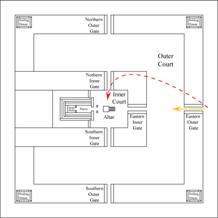 This is the only time
in all of these journeys in and out of the temple, where it was stated that Ezekiel was caught up by the Spirit. Apart from (3.–Out)
when he was “brought back” the same way, all the others were by walking from
place to place. One must therefore
ask: What specifically was Yahweh
attesting to in this?
This is the only time
in all of these journeys in and out of the temple, where it was stated that Ezekiel was caught up by the Spirit. Apart from (3.–Out)
when he was “brought back” the same way, all the others were by walking from
place to place. One must therefore
ask: What specifically was Yahweh
attesting to in this?
We
have now gained sufficient understanding to know the answer to this
question. First, we clearly see
that the glory of Yahweh passing through the east gate, and that gate being
closed as a result, was fulfilled when Yahshua came to this earth and laid His
life down for man.
But
remember, He came early, before the time He was to reign, and the east gate was
closed—it was fulfilled! So,
when He comes again, when will that be?
Of course on the seventh-day sabbath. And, in Ezekiel’s temple, when is the
inner eastern gate to be opened?
Again, on the same sabbath. Therefore, entering into the inner court
from the east is a testimony of the Millennial Reign. And what must take place at the outset
of that reign? The Bride is caught
up into heaven, and returns to rule and reign with Immanuel. Do you see that that is what is being
attested here? The only time
Ezekiel is caught up by the Spirit is when he is transported from the outer
eastern gate representing Yahshua’s coming, and into the inner court representing
the Millennial Reign. This looks to
that day when the Bride will be caught up into heaven, be transformed, and
return to rule and reign with Immanuel (even as Ezekiel was brought back to
that gate). If it had been His time
to reign when He came 2,000 years ago, this is what would have taken
place. But He was early, and the
fulfillment has to wait until the seventh day. This is our hope today.
As
a final word regarding this entire writing, of course there is much more that
could be written about these all-important, impacting, and highly effectual and
determining trinities. But through
this examination you should have a clear idea of how entirely relevant they
are. Again, knowing that Yahweh God
Himself is a trinity, there is no doubt that His works and order would follow
in the same pattern. Today, we can
be most glad that He is opening our eyes to see these truths, and can thereby
take hope that He is indeed having mercy, is indeed cutting time short, and
will in fact establish His Elijah, send the essential latter rain, and prepare
the way for Immanuel to return to this earth to set up His kingdom. Come quickly, Immanuel!
E-Mail
your comments or ask to be notified of future publications
